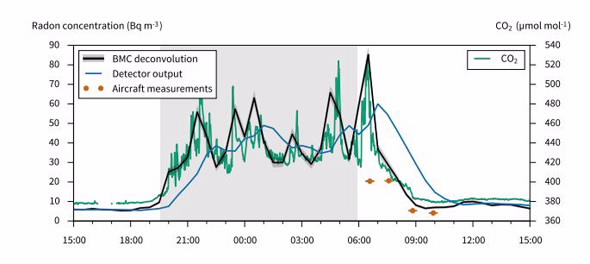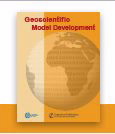
The World Meteorological Organisation (WMO) recognises ANSTO radon detectors as the best in the world for global and regional atmospheric composition and baseline studies. However, ANSTO researchers are making computational refinements to data collected by its instruments in less than ideal conditions.
Until now, to achieve high-sensitivity measurements with ANSTO detectors required a 45-minute response time, which has slightly compromised the usefulness of the two-filter dual-flow-loop style of detector under conditions of rapidly-changing radon concentrations.
This is all about to change.
With the help of an algorithm, inspired by methods used on early images from the Hubble Space Telescope, Alan Griffiths and a team of ANSTO researchers have developed a novel deconvolution method to computationally correct for the radon instrument’s relatively slow time response.
The research has been published in the high-profile journal, Atmospheric Measurement Techniques.
This improvement will enable a far more detailed investigation of atmospheric processes involving abrupt changes in radon concentration, such as the morning transition from nocturnal to daytime mixing conditions, or the rapid synoptic transport of pollutants to places as remote as Antarctica.
The morning transition is of particular interest. This is the period after sunrise when air, trapped overnight in a cold layer near the ground, is warmed by the sun. Warm air rises, and mixes with the air above. Radon that has been accumulating in the inversion layer overnight is quickly carried to altitudes of a kilometre or more during this period, causing the radon concentrations at the ground to drop rapidly.
Even though the actual radon concentrations are dropping quickly, the detector reports a gradual change due to its slow response. This effect can be large enough to persist into the mid-afternoon, making the measurement less useful for tracing atmospheric mixing and pollution dispersion.
“This is not surprising, because we know that the radon detectors take time to respond. But I was surprised to see it persist into the afternoon, meaning that, if you want an accurate time series under those conditions, you need to apply the correction,” explained Griffiths.
Dr Griffiths’ team first conducted a laboratory experiment to simulate the detector response to a short pulse of radon, and used the results to validate their computational model. They then compared radon with carbon dioxide measurements from an earlier field campaign.
Variations in carbon dioxide, which can be measured using a fast-response sensor, should happen together with radon variations, because both are affected by the same processes.
“In this case we found that the insertion of a 45-minute time lag in the data, which is a standard approach that has been used in the past, didn’t really help that much,” said Griffiths.
 |
| Field observations from a calm and clear night on the 5th–6th of November 2011. The wind speed was < ~1 m s−1 at 2 m a.g.l. for most of the night. Aircraft measurements were made 36–41 m .a.g.l. over 6 km flight segments. Night-time is shaded grey, as is the 16th–84th percentile range about the reconstructed time series. |
However, after the computational correction, the radon fluctuations matched the timing of variations in carbon dioxide.
“Night time is difficult for modelling transport, so radon measurements on these clear nights give us valuable information for improving the models,” said Griffiths.
ANSTO’s Atmospheric Mixing and Pollution Transport (AMPT) group conducts experimental research using radon, a naturally-occurring radioactive trace gas of terrestrial origin.
The group develops unique instrumentation systems for surface, tower and aircraft based platforms, supported by specialised laboratory sample processing and analysis facilities, and deploys them in measurement programs as part of national and international efforts to advance scientific knowledge of the earth’s atmosphere and pollution transport.
http://www.atmos-meas-tech.net/9/2689/2016/amt-9-2689-2016.pdf
ANSTO collaborates on major evaluation of atmospheric transport model using radon
One important use of Griffith’s new response time correction technique will be to improve global and regional transport and climate model evaluations that use radon as a tracer, such as the example in a recently published study.
Five ANSTO-built radon detectors in The Netherlands (2), France, Italy and UK were used in a comprehensive study to evaluate a global atmospheric transport model (TM5) for Europe. The evaluation used measured radon concentrations to diagnose the modelled boundary layer dynamics and associated variability of trace gases close to the surface. The evaluation was published in Geoscientific Model Development.
An international group of researchers, including Alastair Williams from ANSTO, were involved in the evaluation of the boundary layer dynamics of the TM5 model.
The model simulations of atmospheric radon activity were driven using a new radon flux map providing quasi-continuous radon surface emission estimates based on data from a total of ten European monitoring stations. Simulations using the new flux map (developed by Karstens et al in 2015) showed significant improvements over simulations using constant radon fluxes, especially regarding average seasonal variability.A similar flux map was developed for Australia by Alan Griffiths in 2010, and published in Atmospheric Chemistry and Physics.
ANSTO’s dual-flow-loop, two-filter radon detection technology is used for highly sensitive measurements of atmospheric radon.
Published: 28/09/2016



